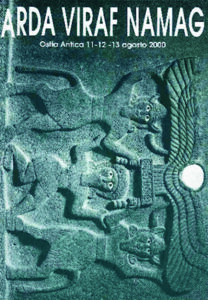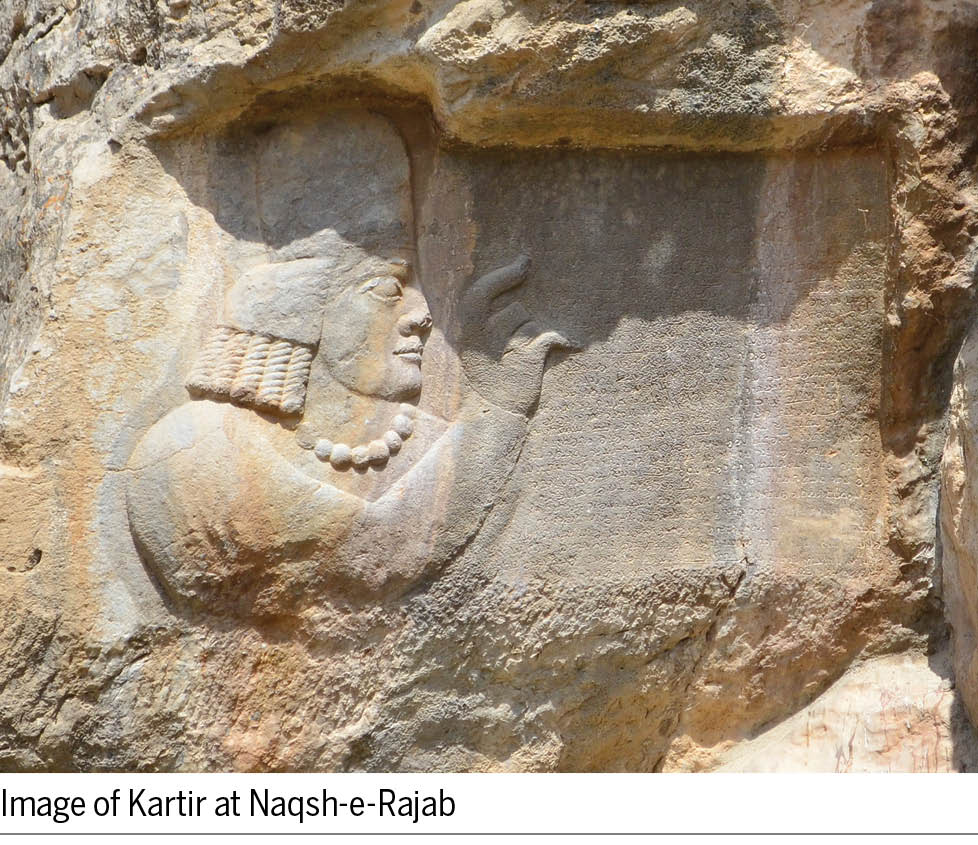 In Iran, the third century AD was a period of religious revival and consolidation of the Zoroastrian faith, where Sasanian rulers officially embraced Zoroastrianism as the state religion, actively promoting its practices and beliefs. Earlier, post Alexander’s invasion and the fall of the mighty Achaemenian Empire, the Zoroastrian religion suffered a setback. The Greeks tried to Hellenize Iran, imposing their beliefs and culture, and succeeding to an extent. Some provinces like Pars continued to offer stiff resistance. Soon followed the rise of the Parthian Empire, and the religion of Zarathushtra began regaining strength. However, under Ardashir Babakan, founder of the Sasanian dynasty, Zoroastrianism flourished and was institutionalized into a powerful, vibrant state religion. A number of Atash Bahram (Fire of Victory) were established and ancient texts were recompiled.
In Iran, the third century AD was a period of religious revival and consolidation of the Zoroastrian faith, where Sasanian rulers officially embraced Zoroastrianism as the state religion, actively promoting its practices and beliefs. Earlier, post Alexander’s invasion and the fall of the mighty Achaemenian Empire, the Zoroastrian religion suffered a setback. The Greeks tried to Hellenize Iran, imposing their beliefs and culture, and succeeding to an extent. Some provinces like Pars continued to offer stiff resistance. Soon followed the rise of the Parthian Empire, and the religion of Zarathushtra began regaining strength. However, under Ardashir Babakan, founder of the Sasanian dynasty, Zoroastrianism flourished and was institutionalized into a powerful, vibrant state religion. A number of Atash Bahram (Fire of Victory) were established and ancient texts were recompiled.
The powerful Sasanian Empire ruled for four hundred and twenty-seven years (224 AD to 651 AD) and was known for the revival of Persian culture, religion and traditions. This change was possible thanks to some stalwart Zoroastrian priests with exceptional qualities of leadership and devotion towards the faith. This article explores the contribution of just three impactful priests of that period.
Herbad Tansar
A Parthian aristocrat, who joined King Ardashir I to became ‘Herbadan Herbad’ during his reign, Tansar was commissioned with the herculean task of recompiling the Avesta, which was fragmented and virtually lost after Alexander’s invasion of Iran and the burning of the library at Persepolis. To grasp Alexander’s destruction, consider the Oriental Institute of Chicago’s view, terming his burning of Persepolis ‘barbaric’. Across Persia, libraries of Zoroastrian texts were destroyed and priests were slain. Greek historian Plutarch noted he looted treasures using 20,000 mules and 5,000 camels!
Despite attempts made even during the Parthian dynasty to recompile the Avesta, it was only during the reign of Ardashir and under the leadership of Herbad (Ervad) Tansar that this task was successfully completed. The fourth book of the Pahlavi Denkard affirms: “The lord, Ardeshir Shahnashah, the son of Babak, with the guidance of Tansar, collected all the religious teachings that were scattered and brought them to the court of Ardashir. Tansar chose the more correct ones, leaving out the other (dubious) sections, and thus commanded: ‘From now on, only the correct ones are the appropriate interpretations based on the Mazdayasna Deen, because now there is no lack of knowledge about them’.”
Tansar’s letter to King Gushnasp of Tabaristan was written following the overthrow of the Arsacid or Parthian dynasty by Ardashir I. In his letter, Tansar accused the Arsacid kings of corrupting Zoroastrianism by introducing unauthorized practices, such as dynastic fires. He portrayed Ardashir as the legitimate restorer of the true faith and emphasized the inseparable bond between the Zoroastrian church and the Iranian state, with Ardashir as its protector.
Dastur Arda Viraf
An important religious exercise undertaken during Ardashir Babakan’s reign was to spiritually transport the soul of a pious priest named Arda Viraf into the spiritual world. Ardashir assembled forty thousand Zoroastrian priests and selecting forty priests, of which seven were chosen on the basis of their learning, wisdom and piety. Among them, Arda Viraf emerged as the most pious and worthy candidate for the spiritual exercise or khalla-e-Badan (astral protection of the soul into the other world).
It is said, the pious Arda Viraf entered an Atash Bahram called Adar Khordad (Fire of Perfection), offered prayers and drank a special consecrated wine. Thereafter, he went into a spiritual trance for seven days, with forty thousand priests sitting around him, offering prayers and keeping constant vigil. Arda Viraf is probably the first human being to have experienced what a human soul undergoes at the time of death, traverse the different spiritual regions and return to the physical body, after a long span of seven days. It was a miracle which rekindled the faith among Zoroastrians in early Sasanian Iran.
With the aid of Bahman (Divine Wisdom), Ardibehest (Divine Truth) and Sarosh (Divine Consciousness – also the guardian of the souls of the living and the dead), the pious soul of Arda Viraf was able to perceive and experience the fate of various souls in the spiritual world. His soul returned to his physical body on the eighth day after its sojourn in wahisht (heaven), dozakh (hell) and hamtstagan (purgatory). His experience of these worlds, or ‘planes of existence’, or ‘states of consciousness, were recorded in the text, ‘Ardaz Wiraz Namag’. This text aimed to strengthen believers’ faith by highlighting good deeds and affirming Zoroastrianism as the sole true path, urging its unwavering preservation.
Mobad Kartir
Kartir was a powerful and influential Zoroastrian priest during the reigns of four Sasanian kings. He began his career under Ardashir Babakan to restore the purity of the Mazdayasni religion. Under Ardashir’s successor Shapur I, he held the title of Ehrpat (master of learning) and under king Hormizd, he was elevated to the rank of Magaput, or Chief of Mobeds.
Kartir played a key role in suppressing heretical sects within the Sasanian Empire, especially targeting Manichaeism—a dualistic religion founded in the third century AD by Mani, known to his followers as the “Apostle of Light.” Born in southern Babylonia (now Iraq), Mani claimed at age twenty-four to have received a divine revelation, commanding him to publicly proclaim his doctrine. He saw himself as the final prophet in a spiritual lineage that included Zarathushtra, Buddha, and Jesus. Mani believed earlier revelations were limited by language and geography and had lost their original truth over time. To preserve unity and avoid corruption, he committed his teachings to writing and established them as canonical during his lifetime, promoting a universal and enduring faith.
Manichaeism, a form of Gnosticism, taught that divine souls are trapped in the material world and can be freed through secret knowledge (gnosis). Though tolerated by King Shapur, Mani was imprisoned and died under Bahram I, influenced by Kartir. Mani also opposed Zandiks – Zoroastrian heretics who reinterpreted the Avesta based on their own beliefs.
During the third and fourth century, Buddhism and Christianity was also making inroads and starting to influence Zoroastrians. Kartir’s inscriptions, particularly at Kaba-e-Zartosht and at Naqsh-e Rajab, mention his efforts in suppressing Buddhists (or Sramans) alongside other non-Zoroastrian religious groups like Christians, Jews, Mandaeans, and Manichaeans. Kartir claims to have ‘struck down’ these groups, indicating an effort to enforce Zoroastrianism and suppress other religious practices. Kartir’s efforts, including the construction of fire temples, supressing the rise of other religions and heretical orders, demonstrate his influence and role in shaping the religious landscape of that era. Sasanian priests held significant roles in the Empire, as religious leaders, advisors, judges and even tax collectors, being instrumental in reviving and preserving religious and cultural traditions.
- દએ મહિનો – કૃતજ્ઞતાનો મહિનો - 24 May2025
- પારસીઓનું ક્રોનિક્લિગં:ગ્રામીણ જીવનનો અભ્યાસ - 24 May2025
- સુરતના સર જે જે આદરિયાને 199માં સાલગ્રેહની ઉજવણી કરી - 24 May2025
